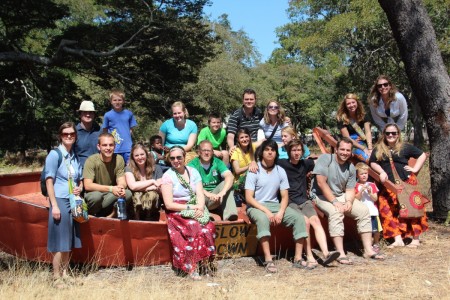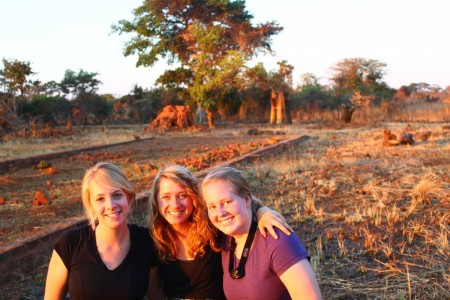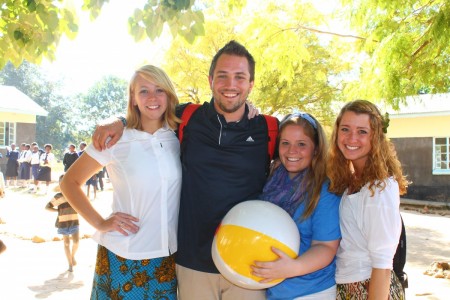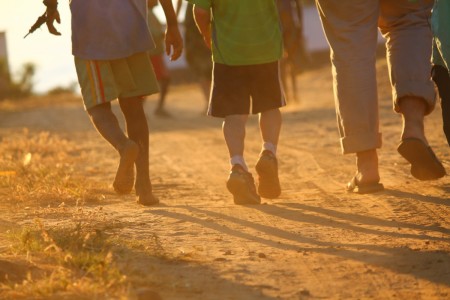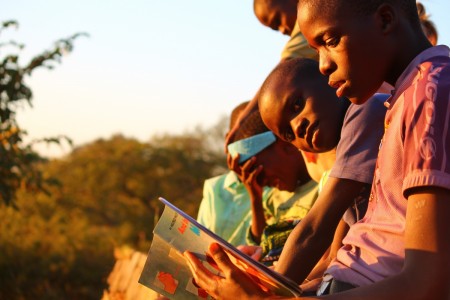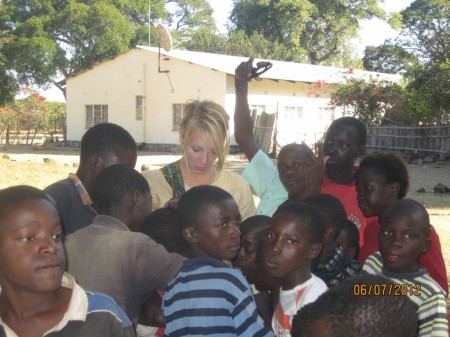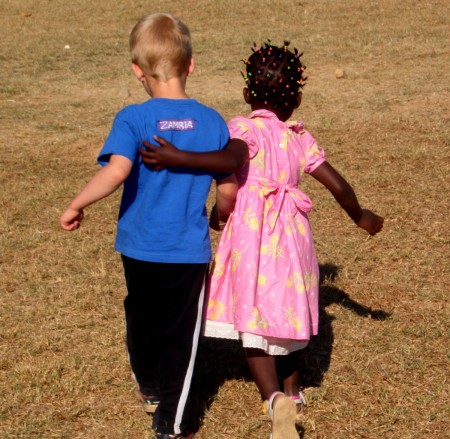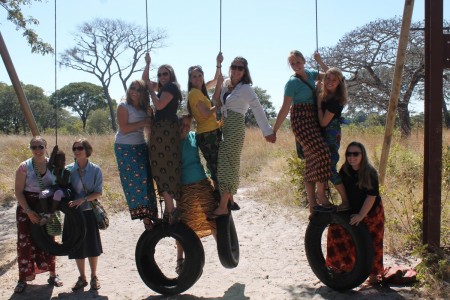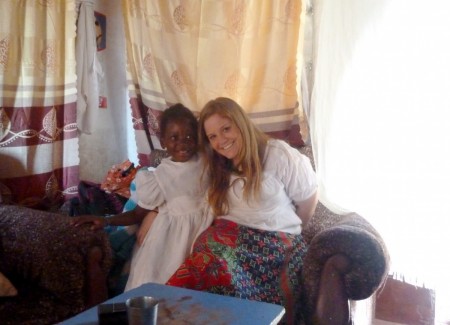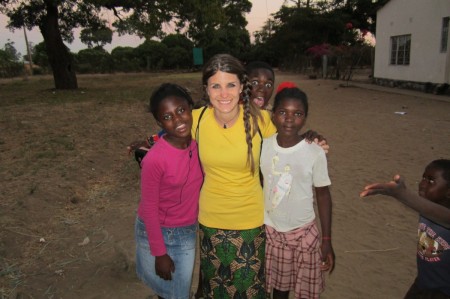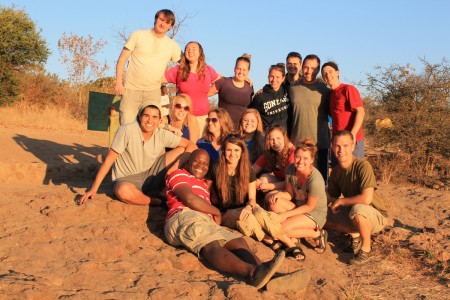Departing for Africa, the experience of a lifetime, meant that I was leaving two 96-year-old grandmothers and my pregnant sister on bed rest. All very emotionally trying situations. Allowing myself to be worlds away from them, meant that I may miss the birth of my niece or that I may not be there for my family if crisis were to occur with my grandmothers. Both life and death, were sitting on the doorstep of my home, when I said goodbye to my loved ones.
We have been surrounded by so much life every day we have been in Africa, let alone Zambezi. The children have so much life and energy as they greet us with beaming smiles and excitement, whether it be at the convent doors, outside the shops in the market, or even when they charged the planes when we landed n the dirt airstrip in Zambezi. As Brady has put it, the children indulge in happiness. This is really the only way to explain it. We can see such life in the church. We can feel and experience the Zambian’s life through their music and dance. We see so much life, in the way they greet everyone they pass and in the passion and excitement they show in the computer, leadership, education and health classes. We have even been able to experience the miracle of life, when watching a baby giraffe being cleaned and cared for by its mother, only thirty minutes after it’s birth.
While we have been immersed in so much life, death has been in the shadows and present in many situations. On the safari, the realities of the circle of life were in our face. As we watched a leopard chow down on an impala, oblivious to the fact that its time had come. We were hit with the reality of death and how quickly life can end, when we heard the tragic news of friends’ and fellow missionaries losing their life in a plane crash. We could feel the cold shadow of death when we returned a HIV positive woman, suffering with TB to her home. She couldn’t have weighed more than 80 pounds and had to be carried, for she was too weak to stand or walk on her own. We have even seen and heard death, while watching Megan, Melissa and Brady, murder for the first time as they each beheaded chickens, in order for the group to be fed.
The paradox of life and death, the joys and hardships in both, surround us each and every day. I often find myself reflecting on these realities of life, when seeing the sun rise and set. The sunrises and sunsets have been bookends to our days. The sunsets often leave me thinking of the miracle of life, while the sunset, reminds me of how quickly one day can pass, how precious every moment is, and how we must not waste our time on insignificant quarrels or worries.
As I have reflected on my experience here so far, I realize the immense amount of supported I have been given by those who I now consider family, as I worry, hope and pray for the best for my family while abroad. I have realized that the world is much bigger than ourselves. Much bigger than I ever imagined. That we are never alone in our worries. I have come to believe that there is a bigger plan for us all and we can not allow ourselves to wallow in the “what ifs.” That all things, whether sad and painful like the death of a loved one or joyful like welcoming a new life to this world, are meant to happen with or without us, whether we like it or not. They are experiences that guide us, shape us, and teach us.
The biggest lesson I have learned thus far is that no matter what struggles we may face, we must love, we must live and most of all we must be free.
Anne Reid
Class of 2014
P.s. To my family:
Mom: the comments have been wonderful to hear! Keep them coming! I am rationing out my liquids and it looks like they will make it the whole month.
Dad: Happy Father’s Day Dad!! I love you and can’t wait for our golf lessons when I get back.
Joyce: I think about you everyday! Keep that bun in the oven! Also when I see all the chitengis I think of all the cool projects we could do with the fabric. Ill bring as much as I can home ☺
Emily: I got some great elephant photos for you. Oh and the apples here are delicious. I think of you every time we have one!
Shaun and Danielle: I know you don’t get married for another week or so, but this will be the only chance I get to say CONGRATS!!! I am sure the wedding will be amazing. Danielle, welcome to the Reid clan!
P.P.S. To friends:
I love you all! Please keep reading the blog. I miss you all like crazy and can not wait to share all my sorties with you when I return!! And special shout out to Cole Cummins! Congrats of finishing Jr. High, buddy!!!
P.P.P.S TO THE DADS!!!!!!!!!!!
Hi daddy!! Happy happy father’s day!! I am so blessed to have such a wonderful role model in my life. You are simply the best 🙂 love you so much and I cant wait to get home to give you a GIANT hug. Much love always xo- Kate
Papa!! Happy Father’s Day!! I was listening to “Pride and Joy” today by Stevie Ray and I thought about you, as always! I hope that you and Erin and Mom got to spend a beautiful day on the Irish Wake at Chatfield! I miss you more than I can say and absolutely can’t wait to see you again! I love you. – Megs
Hi dad! I hope you and mom are having an amazing trip and I can’t wait to see you in a week and a half! I love you!!!!!!!! Xo – Analise
Dad! I’m sorry I’m not home for Father’s Day but I hope Mom, Colleen, and Sean treat you to something cool! You deserve it ☺ Much love – Kyle
Dad!! I miss you so much and can’t wait to see you soon! I hope all is well at work! Please say hello to the ladies for me. Enjoy Father’s Day! Mom, HAPPY BIRTHDAY! You deserve to have the best day ever! I love you all! Xoxoxo Erin
Daddy! Every time I look in the mirror or see a picture of myself, I can’t believe how much I look like you, especially without makeup! I’m so blessed to be your “Roya” and think about you every day. I assume you’re with Dar and the kids today, give them all hugs and kisses from me. Love you Dad and I can’t wait to see you in North Carolina (or Jersey) when I get back! Happy Father’s Day!! -Paige
As we tied a goat to the roof today in preparation for an upcoming meal, I couldn’t help but think you’re enjoying pulled pork or brisket. Happy Father’s Day, Dad! I love you! –Nolan
It is great being here with Josh and the Armstrong family but it was hard to be away this Father’s Day. I hope all is well, I miss you and love you. Thanks for everything. – Mateo Trujillo
I was really missing you today pops! I hope your Father’s Day has been great, can’t wait to be back and have a brew with ya! Hope you are cheering on my team right now, love ya big guy. – Alex Dickman
Hi Daddy! I miss you like crazy! Today at church in Dipalata the choir director used the Martin and the music was wonderful! You would have absolutely loved the worship, considering it was 80% of the Mass! Happy Father’s Day Papa! I feel soooo blessed to have you as my daddy! Love you and miss you! ~Stef
Happy Father’s Day Pops! I really wish I could be there to hang with you. We will have to celebrate when I get back with a Corona and lime. I honestly couldn’t ask for a better father, role model, or best friend. I love you a ton! You da man Ricky J! –Jay Orth
Hey Daddio! I hope you are having the happiest of Father’s Days. Even though I cannot be there to bring you breakfast in bed and jump on you to wake you up, know that you have been on my mind all day and will be getting some great bear hugs on my return. I love you so much. Thank you for everything. -Brady
Hi Dad. Happy Father’s Day! Hope your day is great! Things are amazing here in Zambezi. Hope they are where you are as well! There are certain things here that remind me so much of our time in Egypt together and I can’t help but think of that and miss you. Love you lots, and Happy Father’s Day! Also, happy double-deuce birthday, Mitch! I have been thinking about you and wondering what you are up to, and wishing so much I could have talked to you on your actual birthday. Sending prayers your way for all of your decision-making! Love to you and the fam (Mom, Randy, Matt, Rebekah, and everyone else!) as well! Look for my blog post in a couple days! Love you all! -Melissa ☺
Happy Father’s Day, Dad!!! I hope that you have an awesome Father’s Day with Grandpa Korman! Melissa and I have been thinking about all of you and hope that Liezl’s graduation and Johnathan’s wedding were great! We truly wish we could have been there for all the festivities. We also hope that the first month of your retirement has been great and that you’re having fun and relaxing!!!! Thanks for being an amazing Dad and for all of the ways you have shown your love to us throughout the years!!!! Melissa and I are doing great and really enjoying our time in Zambia and have been very blessed and inspired by the love and hospitality of the people here. You, Mom, Dan, Chris, and Rose are constantly in our thoughts and prayers!!! Love, Dave

